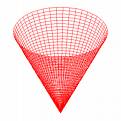 Calculating Cones
Calculating Cones 
 Calculating Cones
Calculating Cones 
In this lesson students work on a real-lfe problem: calculating the volume of buoys
Author : Monika Schwarze, Hamm, Germany and Bianca Gonterney, Münster
Grade Level/Subject : (9-12), Math or Science
Overview :
Purpose :
Having a high amount of self-guided learning and improving problem-solving skills.
Resources/Materials :
Activities and Procedures :
So it has worked in my lessons:
Students work in groups of 4 students. They get one common problem. But the difficulty is that the information for the task is split up on 12-16 individual cards. Each student gets 3-4 cards. They are allowed to look at the information on their hands, and are allowed to talk about it, but they mustn't put it down on the table. That way they are forced to share information by talking about it (this is especially difficult by describing pictures or tables). Another difficulty is to actually find out what the task is. They can take notes and are supposed to solve the given task in a certain amount of time, and be able to present their solution to the rest of the class at the end of the lesson (e.g. on a transparency).
There are two options for this:
A: each group has a different task to work on and all groups present at the end (takes a long time)
B: all groups work on the same task and only one group is picked for a presentation of the solution and the rest of the class contributes to it.
For a group that hasn't worked with a method like that I'd suggest option B.I explained the way of working to the students. Then they got the cards and tried to find some questions and answers. Before I had given them them the hint that there is more than one single question and one caculation of volume in the problem. It takes a little bit more than 45 minutes ( a lesson in Germany normally has 45 minutes) as I had expected before.. In the next lesson they finished their work and prepared a presentation via blackboard. Because of more than one questions and answer (sewe below) in the problem all groups had contributed to the solution of the whole problem.
I put attention on their explanations how (!) they solved the problem because my intention is to broaden the student's problem solving competencies whenever possible.
Evaluation:
It was highly motivating for almost all students. Weaker ones feel more integrated because they really contribute to steps of the solution and got more self-confidence (as some of them said). All students were active at the same time in comparision of working whole-class. The first time the students need more time to get comfortable with this learning method. If you use this method the second, third time the students don't have these problem to start with their work. All classes in which I introduced this method like it very much because it is somewhat indifferent to "normal" teaching.
This puzzle-method can be transferred to almost all topics when you work with real-life problems or more complex problems. it takes only a few time to "cut" a problem of a maths textbook into differents parts/information. It doe not matter if 1-3 of them are not relevant for the solution.
Questions that the students may find while working on the problem?
1. What about the volume and weight of the buoy on the picture?
2. What about the surface and the weight of the shell?
3. Calculate the weight of a sphere of styrofoam which has the same radius as the buoy. Compare the weights!
4. Calculate the weight of buoys made of cork!
5. What's about the volume of a buoy that consits of two equal cones and has a diameter?